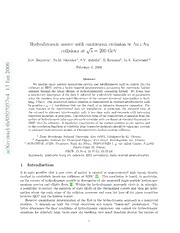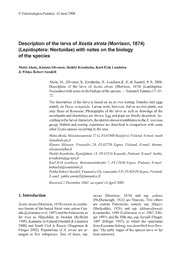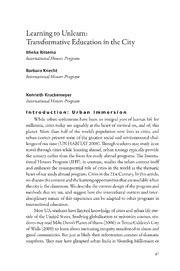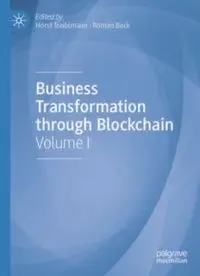
Business Transformation through Blockchain: Volume I PDF
Preview Business Transformation through Blockchain: Volume I
Edited by Horst Treiblmaier · Roman Beck Business Transformation through Blockchain Volume I Business Transformation through Blockchain Horst Treiblmaier • Roman Beck Editors Business Transformation through Blockchain Volume I Editors Horst Treiblmaier Roman Beck Department of International Management Head of European Blockchain Center MODUL University Vienna IT University of Copenhagen Vienna, Austria Copenhagen, Denmark ISBN 978-3-319-98910-5 ISBN 978-3-319-98911-2 (eBook) https://doi.org/10.1007/978-3-319-98911-2 Library of Congress Control Number: 2018959421 © Te Editor(s) (if applicable) and Te Author(s), under exclusive licence to Springer International Publishing AG, part of Springer Nature 2019 Tis work is subject to copyright. All rights are solely and exclusively licensed by the Publisher, whether the whole or part of the material is concerned, specifcally the rights of translation, reprinting, reuse of illustrations, recitation, broadcasting, reproduction on microflms or in any other physical way, and trans- mission or information storage and retrieval, electronic adaptation, computer software, or by similar or dissimilar methodology now known or hereafter developed. Te use of general descriptive names, registered names, trademarks, service marks, etc. in this publication does not imply, even in the absence of a specifc statement, that such names are exempt from the relevant protective laws and regulations and therefore free for general use. Te publisher, the authors and the editors are safe to assume that the advice and information in this book are believed to be true and accurate at the date of publication. Neither the publisher nor the authors or the editors give a warranty, express or implied, with respect to the material contained herein or for any errors or omissions that may have been made. Te publisher remains neutral with regard to jurisdictional claims in published maps and institutional afliations. Tis Palgrave Macmillan imprint is published by the registered company Springer Nature Switzerland AG Te registered company address is: Gewerbestrasse 11, 6330 Cham, Switzerland Preface Volume I Te blockchain and related technologies have taken many academic com- munities by surprise. Its technological foundations were developed over various decades but were mainly discussed in communities specialized in computer science and cryptography. Even the 2008 seminal publication from the pseudonymous author Satoshi Nakamoto entitled “Bitcoin: A Peer-to-Peer Electronic Cash System” failed to attract immediate atten- tion within the industry, the general public and in most academic com- munities. In this nine-page paper with an unassuming title, Nakamoto, whose real identity has yet not been revealed, combined various existing technologies and was able to solve the so-called double-s pending prob- lem by clever engineering. Te result was the frst cryptocurrency, a mon- etary system that should not have been able to survive, if one believes many economic theorists. Yet, over the years, the general public began to take notice, and Bitcoin was able to bootstrap itself into a currency in which people invested fat money. In parallel to the soaring exchange rates of Bitcoin, various authors became interested in the underlying technology and its potentials. All of a sudden, the “Internet of Information” turned into the “Internet of Value”, and wild speculations started circu- lating about what can potentially be done with this new technology. This phase is far from over and was not stopped by the dramatic losses which Bitcoin experienced at the end of 2017. Given that the technology is still under development, business models are largely v vi Preface Volume I unexplored, and a comprehensive legal framework is missing, aca- demics pursuing research that is relevant for the industry started investigating the blockchain phenomenon and related technologies from various angles and with different goals in mind. Tis two-volume book entitled Business Transformation through Blockchain contains a selection of articles from researchers who are interested in the implications of the blockchain. Te focus is not on technical details but rather on the impact the blockchain can have on diferent industries. A total of 22 papers are divided into six diferent sections and one appendix. Te respective sections are “Foundations of blockchain”, “Finance”, “Selected Use Cases”, “Sustainability”, “Society”, and “Legal Issues”. Te frst two sections will be published in Volume 1 and the other four in Volume 2. In the section on blockchain foundations, various articles are published that look at the blockchain and related technologies from a broad perspective and investigate topics such as economic impact and long-term adoption. Te section on fnance includes four chapters that closely inves- tigate fnancial aspects of blockchain technology, ranging from fnding the optimal investment portfolio to novel applications of crowdfunding. Melanie Swan, who authored the frst chapter, discusses how the adop- tion of blockchain technology might actually contribute to solving a larger class of economic problems related to systemic risk. Trevor Clohessy, Tomas Acton, and Nicholas Rogers conduct a comprehensive literature review and derive, based on the technology-organization-environment (TOE) framework, important blockchain adoption considerations. Andranik Tumasjan and Teodor Beutel apply agent-based modeling to explore the circumstances under which a decentralized sharing economy business model might achieve widespread adoption. Florian Glaser, Florian Hawlitschek, and Benedikt Notheisen investigate the blockchain as a platform and present technical layers of the system as well as institu- tional characteristics and governance implications, followed by a discus- sion of the role of trust in blockchain systems. Finally, Ben Van Lier takes a wider perspective investigating the autonomy and self-organization of cyber-physical systems. Te second section on fnance is opened by Karl Weinmayer, Stephan Gasser, and Alexander Eisl, who explore the question of whether Bitcoin as an unregulated cryptocurrency can have a positive Preface Volume I vii efect on well-diversifed portfolios. Friedrich Holotiuk, Jürgen Moormann, and Francesco Pisani take a close look at blockchain in the payments industry. Tey present the results from a Delphi study and develop a discussion agenda based on pain points and opportunities. Laurin Arnold, Martin Brennecke, Patrick Camus, Gilbert Fridgen, Tobias Guggenberger, Sven Radszuwill, Alexander Rieger, André Schweizer, and Nils Urbach identify industries and use cases that may beneft from adopting block- chain when it comes to crowdfunding. Tey show how crowdfunding and initial coin oferings difer and how the latter is reshaping the former. Finally, Paolo Tasca investigates how the insurance industry might be impacted by blockchain technology. Vienna, Austria Horst Treiblmaier Copenhagen, Denmark Roman Beck Contents Part I F oundations 1 1 B lockchain Economic Networks: Economic Network Theory—Systemic Risk and Blockchain Technology 3 Melanie Swan 2 B lockchain Adoption: Technological, Organisational and Environmental Considerations 47 Trevor Clohessy, Tomas Acton, and Nichola Rogers 3 B lockchain-Based Decentralized Business Models in the Sharing Economy: A Technology Adoption Perspective 77 Andranik Tumasjan and Teodor Beutel 4 B lockchain as a Platform 121 Florian Glaser, Florian Hawlitschek, and Benedikt Notheisen ix x Contents 5 B lockchain Technology: The Autonomy and Self- Organisation of Cyber-Physical Systems 145 Ben van Lier Part II F inance 169 6 B itcoin and Investment Portfolios 171 Karl Weinmayer, Stephan Gasser, and Alexander Eisl 7 B lockchain in the Payments Industry: Developing a Discussion Agenda Based on Pain Points and Opportunities 197 Friedrich Holotiuk, Jürgen Moormann, and Francesco Pisani 8 B lockchain and Initial Coin Offerings: Blockchain’s Implications for Crowdfunding 233 Laurin Arnold, Martin Brennecke, Patrick Camus, Gilbert Fridgen, Tobias Guggenberger, Sven Radszuwill, Alexander Rieger, André Schweizer, and Nils Urbach 9 I nsurance Under the Blockchain Paradigm 273 Paolo Tasca I ndex 287 List of Figures Fig. 2.1 Google trends result for the search term ‘blockchain’ (Google 2018) 49 Fig. 2.2 Literature review mapping process. (Adapted from Kitchenham and Brereton (2013)) 58 Fig. 3.1 Perceived-beneft-matrix (left) and internal/external trigger- matrix (right) 97 Fig. 3.2 Short-term scenarios of perceived-beneft-matrix (100 time units) 98 Fig. 3.3 Long-term scenarios of perceived-beneft-matrix (1,000 time units) 9 Fig. 3.4 Short-term scenarios of internal/external trigger-matrix (100 time units) 103 Fig. 3.5 Long-term scenarios of internal/external trigger-matrix (1,000 time units) 104 Fig. 4.1 Technical layers of a blockchain system, based on Glaser (2017) 124 Fig. 4.2 Te dimensions of institutions 129 Fig. 4.3 Te institutional dimensions of blockchain-based platforms 132 Fig. 4.4 Prevalent trust targets in two-sided markets from a blockchain IS users’ point of view, based on Söllner et al. (2016) 137 Fig. 5.1 Interoperability of information—I 153 Fig. 5.2 Interoperability of information and interpenetration 154 Fig. 5.3 Interoperability and system-of-systems 157 xi
The list of books you might like

The Sweetest Oblivion (Made Book 1)

The 48 Laws of Power

Better Than the Movies

The 48 Laws of Power

Selected topics in number theory
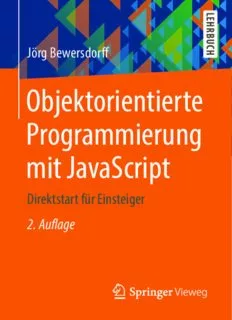
Objektorientierte Programmierung mit JavaScript: Direktstart für Einsteiger

O Rei Mago
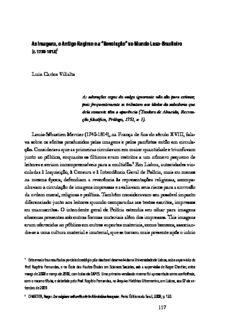
As imagens, o Antigo Regime e a “Revolução” no Mundo Luso-Brasileiro

Warum Manner nicht zuhoren und Frauen schlecht einparken
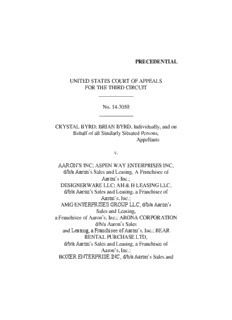
Byrd v. Aaron's, Inc.
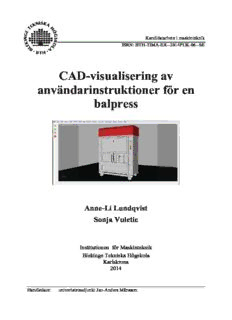
CAD-visualisering av användarinstruktioner för en balpress

Актуальные проблемы частного и публичного права. Вып. 10. Конференция

Diophantus and Diophantine Equations

by Alexandre Dumas adapted by Carol M. Rice

SHORT COMMUNICATION. A new combination and a new subsection in Crepidium (Orchidaceae)

C9553 an Arabic a Colloquial Handbook in the Syrian Dialect
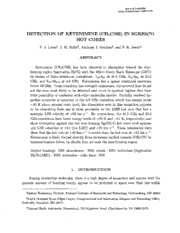
Detection of Ketenimine (CH2CNH) in SGRB2(N) Hot Cores

Análise Multivariada de Dados
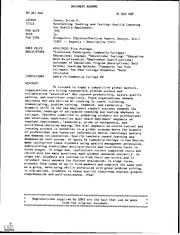
ERIC ED361046: Reinventing Teaching and Testing: Quality Learning for Quality Employment.

Caderno de Iniciação à Pesquisa Vol. 07
